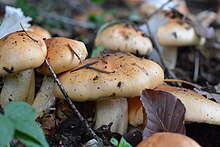|
Hygrophorus pudorinus
Hygrophorus pudorinus, commonly known as the blushing waxycap,[1] turpentine waxycap,[2] or spruce waxy cap,[3] is a species of fungus in the genus Hygrophorus.[4] Swedish mycologist Elias Magnus Fries described it as Agaricus pudorinus in his 1821 work Systema Mycologicum.[5] It became Hygrophorus pudorinus with the raising of Hygrophorus to genus rank. The species name is the Latin word pudorinus "blushing".[6] The species is classified in the subsection Pudorini of genus Hygrophorus, along with the closely related species H. erubescens and H. purpurascens.[7] The fruit body (mushroom) is a fair size, with a 5–12 cm (2–4+3⁄4 in) diameter pink to golden convex cap with a downrolled margin that is lighter in colour. The cap surface is sticky. The pink to yellow-white gills are decurrent. The thick stipe is 4–16 cm (1+5⁄8–6+1⁄4 in) tall and 1–3 cm (3⁄8–1+1⁄8 in) wide.[8] The spore print is white and the oval spores measure 7–10 × 5–6 micrometres. The thick flesh is pale pink or orange to white. The mushroom does not bruise red and has no distinctive odour, though it can taste like turpentine.[1] Hygrophorus pudorinus is found in coniferous woodlands under fir and spruce trees[9] across western and northeastern North America;[1] it is particularly common in Canada[9] and the Rocky Mountains.[6] The mushrooms appear in groups or fairy rings in late summer and autumn.[1] They often grow in boggy places in sphagnum moss.[2] Despite its taste, it is edible after cooking.[9] Its variable appearance makes identification difficult and hence raises risk of misidentification.[1] References
|
||||||||||||||||||||||||||||||||||||||||||||
